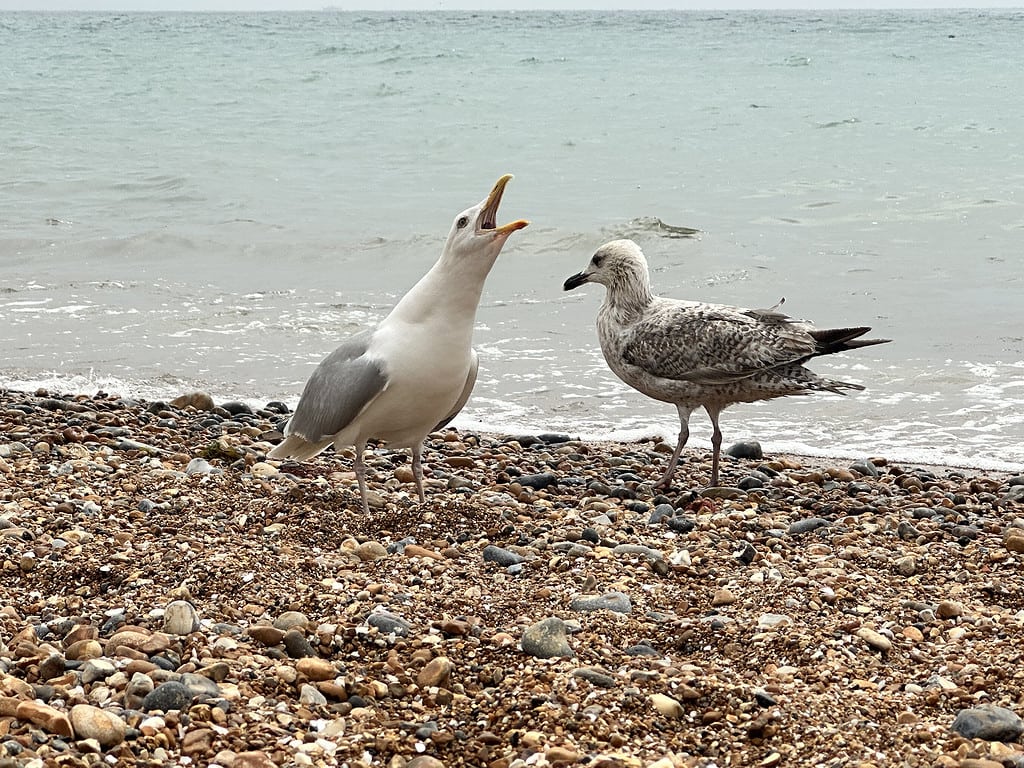Seagulls are some of the most commonly seen birds on earth, probably second only to the pigeon. Although seagulls are originally ocean birds, they’ve been known to follow human activity fairly far inland.
City dwellers who live anywhere near a beach will see them scavenging and foraging in the metropolis. Yet as common as they are at the beach, town, country, and city, very few people have the necessary training to distinguish male seagulls from female seagulls.
At a distance, the two sexes are practically identical. But that doesn’t mean there are no differences between male and female gulls. In fact, there are quite a few distinguishing factors between them that go more than skin deep. Read on to learn about male vs. female seagulls and 5 key differences between the two.
Seagulls: The Basics
Seagulls (scientific name, Laridae) are seabirds found throughout the world. There are over 50 different species of seagulls. The most common gull is the herring gull, but there are also less common seagulls such as the Mediterranean gull, the glaucous gull, and the yellow-legged gull. You hear gulls before you see them: their signature squawks are unmistakable if you’re anywhere close to a beach.
They evolved from an ancient avian which existed around 15 million years ago, during the Cretaceous Era. Their average lifespan is in the range of 10 to 15 years; though certain species, such as the giant black gull and herring gull, can live to over 25.
Seagulls live on fish, crabs, insects, and mollusks, and are experts at foraging through human garbage for a meal. They’re also pro fliers and swimmers. Versatile as they are, you’ll find them living life not just at the coasts, but at lakes, in cities, and even in garbage dumps. In fact, anywhere humans drop food, they can probably eke out an existence. In some places, they’ve become so prevalent and successful at this that they’re considered a nuisance species. Ask any commercial fishery, a favorite amongst gulls!
Symbolically, seagulls have represented independence, the strength of the sailor, messengers from the gods, and even fearful omens, depending on the culture or myth in question. As Willem Defoe memorably mentioned in the movie The Lighthouse: “Bad luck to kill a seabird.” Though it’s considered the worst luck to kill an albatross, seagulls are on the “don’t kill because of sailor superstition” list, too.

Seagulls live on fish, crabs, insects, and mollusks, and are experts at foraging through human garbage for a meal.
©rai/iStock via Getty Images
Male vs. Female Seagulls: What They Have In Common
In short, male and female seagulls look pretty much exactly the same, unless you’re a birdwatcher or a biologist. Both sexes have white to light grey plumage, hooked beaks, and long wings. Most have yellowish-brown eyes. All have webbed feet, well-evolved for swimming. Seagulls are almost unique among animals in that they can drink both fresh water and salt water. They have a specialized gland near their eye that acts as a salt filter, removing it from the gull’s system.
Like nearly all birds, both male and female seagulls have cloaca — an opening below the tail through which waste passes. The male’s cloaca lets sperm out; the female’s lets sperm in. This is also the opening through which eggs will be laid. A male gull’s testicles, and a female gull’s ovary, are internal. So that’s another way in which you can’t tell the boy gulls and girl gulls apart.
Male vs. Female Seagulls: Differences in Size
Now to those oh-so-subtle differences. Male and female seagulls are fairly similar in size; however, the males do tend to outgrow the females by a few millimeters. There’s enough intersection in the two sexes’ growth spectrum that you could have an individual female that is larger than an individual male; but the trend is that the males grow a bit heavier, longer, and with greater wingspan.
But even this differs depending on which species of seagull we’re talking about! Female western gulls (Larus occidentalis) grow larger than the males by about three centimeters, and up to ten centimeters wider in wingspan! However, in most gull species, the males have a slight growth edge. But it’s worth pointing out that, since the difference is minor, you won’t have an easy time telling male and female seagulls apart on this basis. Just being honest!

In short, male and female seagulls look pretty much exactly the same, unless you’re a birdwatcher or a biologist.
©Nicola_K_photos/Shutterstock.com
Male vs. Female Seagulls: Differences in Shape
Male seagulls will tend to have a somewhat stronger, larger, more defined, and in some cases more hooked bill. The seagull’s beak is its most powerful tool and weapon. Given that it more often falls to the male to hunt and defend the nest, whereas the female will more likely incubate the eggs, it makes evolutionary sense that the males would have a little more beak power.
Male vs. Female Seagulls: Differences in Color
Both female and male seagulls have nearly identical plumage patterns: they’re mostly white with gray wings and black-tipped feathers. Yet male seagulls tend to have somewhat brighter, purer, and more brilliant plumage — the white a bit more shiny, the colors more distinct from one another — whereas females will have a duller look or a more mottled or freckled plumage scheme. We have to stress that these distinctions are minor, so much so you’d have to be up close and know what you were looking for before you noticed them.
Male vs. Female Seagulls: Differences in Voice
Here again, seagulls remain pretty mysterious to us humans trying to tell the females and males apart. The usual seagull noises, variously known as yells, barks, or squawks, have no male or female inflection to them.
That said, male seagulls make a few noises that females don’t. During mating season, male seagulls emit vocalizations designed to entice a female partner. The female has no corresponding mating call, so this is one distinguishing vocal factor of the male. Male gulls, when defending territory from other males, will also make louder, more aggressive vocalizations than females do.

During mating season, male seagulls emit vocalizations designed to entice a female partner.
©Chandan Gupta Bhagat/iStock via Getty Images
Male vs. Female Seagulls: Differences in Behavior
Here again, we can look to mating rituals to distinguish between male and female seagulls. During the mating season (usually March to April), male seagulls can be seen courting the females. In addition to the male-only squawks we mentioned above, the males will put on their best flying tricks to show how worthy they are of love — you could call it an airshow. The flyboys will also strut, flaunt their feathers, and puff themselves up, where the females will have no need for such masculine displays.
Males can also be seen carrying food to their desired mates, another sure sign separating them from the females. During the act of copulation, the female will move its tale aside and the male will mount her. This only lasts an instant, but is another moment at which you know which seagull is male and which female.
After that moment, you’ll go back to having a hard time distinguishing them! Mother and father are highly cooperative, alternating parental duties like building their nest, incubating the eggs, hunting for food, and feeding it to their young.
Seagulls mate for life in most cases. (They say you look more and more like your spouse over the years.) In some cases where one or both of the gulls are sterile, a pair of gulls may “divorce” and go their separate ways, hopefully to form a more successful mating pair.
Even so, we know that male seagulls are somewhat more likely to be the hunters and fighters when such duties come up, and the females are more likely to tend to the nest, the eggs, or her hatchlings.
The photo featured at the top of this post is © Joerg-Drescher/Shutterstock.com
Thank you for reading! Have some feedback for us? Contact the AZ Animals editorial team.






